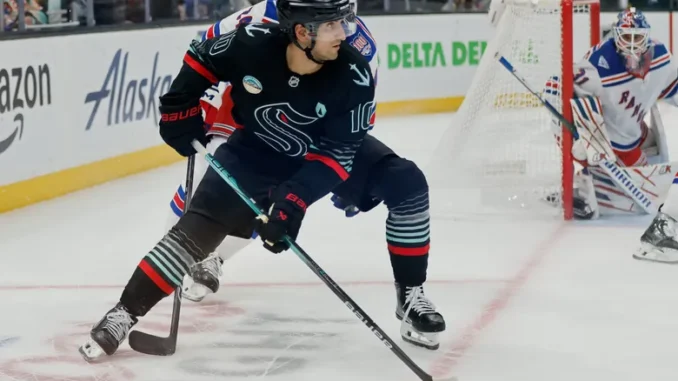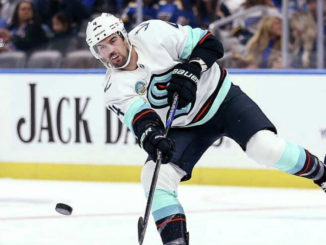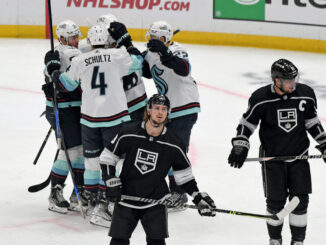
With the Seattle Kraken’s 3-1 win over the Chicago Blackhawks on Monday night, the team’s record improved to 6-2-4 over 12 games, and for at least one night, put them atop the Pacific Division with 16 points.
Their points percentage (PTS%) comes in at .667, which is the best through 12 games in franchise history, eclipsing the .583 rate played by the 2022-23 Kraken. That team finished in a playoff spot, raising hopes in Seattle that this year’s team can accomplish the same feat.
Let’s dive into the factors contributing to Seattle’s strong start to the 2025-26 season, and how likely each is to continue through the rest of the campaign.
Kraken Addressing Last Season’s Defensive Issues
The Kraken shocked the hockey world last season by firing head coach Dan Bylsma only one season into his tenure after the team finished 20 points out of a playoff spot. Bylsma’s ideas never took hold and led to the Kraken’s defensive numbers – a clear strength throughout their brief history – cratering by season’s end.
Now Lane Lambert, Bylsma’s replacement, is tasked with bringing the Kraken back to respectability and restoring their identity as a stout, disciplined hockey club. Judging by the Kraken’s underlying numbers at five-on-five, it appears as though he’s succeeding.
Ignoring the actual goals against helps paint a clearer picture of the underlying strength and stability of a team’s defensive structure, as the quality of goaltending received can distort a team’s defensive abilities, for better or for worse.
| Season | Shots Against | Scoring Chances Against | High-Danger Chances Against | Expected Goals Against |
| 2024-25 | 24th | 24th | 24th | 24th |
| 2025-26 | 23rd | 14th | 13th | 17th |
By both volume and quality, the Kraken are doing a better job of protecting their netminders compared to last season. It doesn’t seem like much on the surface, but jumping into the middle tier defensively is likely worth tens of goals and standings points over the course of the entire season.
Kraken Struggling to Create Offense
Despite Lambert’s success in implementing a more robust defensive system, he has yet to find a solution for the Kraken’s astonishing impotence in attack. They rank last in the league by every meaningful metric, including shots, scoring chances, high-danger chances, and expected goals generated per-60-minutes at five-on-five. They have only scored 1.91 goals per-60, the third-lowest rate in the league.
Some of that can be attributed to Kaapo Kakko (10 games), Jared McCann (seven games), and offensive defenseman Brandon Montour (four games) missing time in October. Less skilled players are being pushed higher in the lineup, but they’ve also played often enough that such a stunning reversal from last season (12th in goals for per-60 but still bottom 10 in the shot- and chance-generation metrics) is worrying.
It appears as though Lambert is overcompensating for his predecessor’s miscues defensively and rendering an already weak Kraken offense even more limp. The improvements in front of their own net mean very little if the team cannot sustain possession in the offensive zone. They are hovering around the 40% mark in terms of their share of shots and chances at even strength, a gaudy number which puts them near the NHL basement and could spell trouble as the season progresses.
Kraken Special Teams at Opposite Ends of the Spectrum
While the Kraken’s inability to score and control the run of play at five-on-five should be the main story, the team’s power play and penalty kill have been notable for different reasons.
With a 23.5% conversion rate (12th in the NHL), Seattle’s power play has been dangerous enough to keep opposing penalty kills on their toes. If they can continue taking advantage, that could go a long way in papering over their offensive woes at five-on-five. Forward Chandler Stephenson leads the Kraken in goals (two) and points (three) on the power play. It should be noted that Seattle still sits in the bottom half of the league in terms of shots and chances created per 60 minutes with the man advantage, while ranking seventh in shooting percentage (SH%). They are running a little hot and will need to pump their underlying numbers up to stem the tide of regression to the mean.
When it comes to the penalty kill, the story is the complete opposite. Despite a miserable 71% kill-rate, the Kraken are comfortably in the top half when it comes to expected goals conceded per-60 and actually lead the league in their rate of high-danger chances allowed. They are keeping opposing power plays out of the inner slot and forcing shots from the outside, but have received some of the worst goaltending in the league while shorthanded (fourth-last at .786). Chances are the goaltending will improve, and so should Seattle’s penalty kill.
Kraken Goaltending Holding Steady
Speaking of the Kraken’s goaltending, the netminders have been decent outside of the environment of the penalty kill.
Joey Daccord has started 10 out of the team’s 12 games this season. The 29-year-old owns a record of 5-1-3 with a save percentage (SV%) of .910 and has saved more than two goals above expected. He’s carried the brunt of the workload for the franchise (111 starts since the start of the 2023-24 season), and Lambert has tapped him to be his main man to start his tenure.
Matt Murray and Philipp Grubauer have each made only one start, both resulting in losses. Murray was signed as a free agent on a one-year deal to push the disappointing Grubauer for the backup role, despite the latter being the 16th-highest-paid goalie in the NHL this season. Grubauer’s plight since joining the team ahead of the Kraken’s inaugural season has been well-documented. Still, his contract (two years remaining, including this one) has kept him tethered to Seattle despite the pitiful return on investment.
Overall, the Kraken rank second in team SV% at five-on-five and sixth in all situations. It’s difficult to scoff at receiving above-average goaltending leaguewide, even if the team currently ranks fourth in the NHL in terms of salary cap allotted to netminders.
Kraken Have Reasons for Optimism
Despite a complete lack of offensive creation, penalty kill concerns, and another season spent fretting about the goaltending carousel, there are plenty of reasons to be optimistic in Seattle.
The team has already picked up valuable points in the playoff race, including three wins over direct division rivals.
The Kraken have also been able to tread water despite missing three of their key offensive players for most of, if not the entire month of October. Getting them all back in the lineup should spark some creativity throughout the lineup.
With the usual asterisks for early-season noise aside, the Kraken’s rest-of-season schedule is one of the easiest in the league thanks to a weak Western Conference and Pacific Division. Two of the bottom three teams in the league are in the Pacific, while the West boasts the entirety of the bottom six.
The Kraken’s young players are still developing and could be completely different players by the end of the year. Patience is a virtue, and one the organization should practice through the fall.
Data courtesy of Natural Stat Trick and the NHL.





Be the first to comment